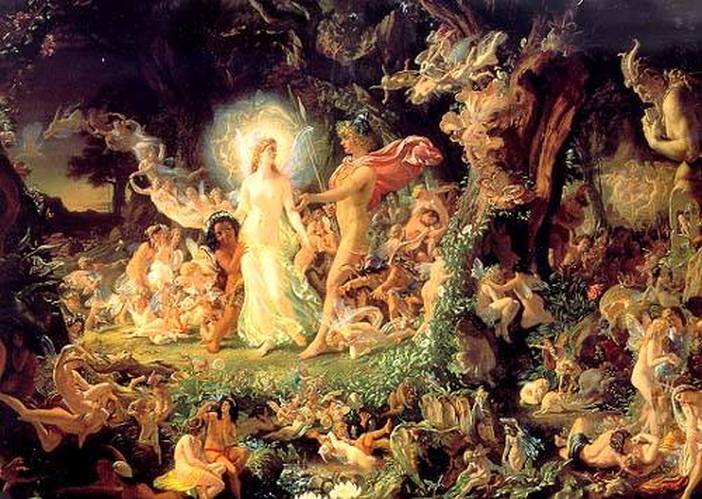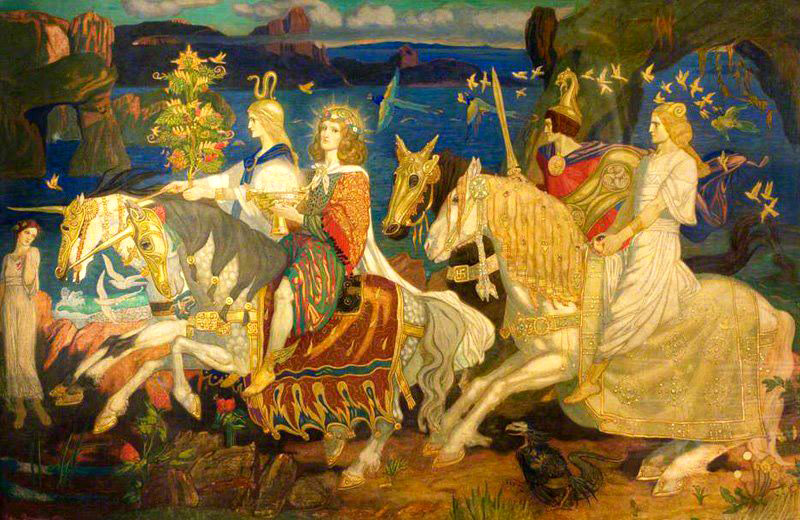There is a calling to some when St. Patrick's Day rolls around. We are entertained by evolved images of fairies and tricky leprechauns. While the little people dance now within all too cartoonish realms such as cereal boxes and Disney cartoons, they were once a practice of belief and a way of life. To the ancient Celts, faeries or "The Good Neighbors" as the called them, existed as nature spirits dwelling within the sea as well as the forest. The earliest accounts of fairies describe figures who weren't always tiny but able to take many dynamic forms. The idea that a fairy is a tiny benevolent creature is fairly modern, the advent of it's wings being it's most recently described detail.
 |
| Jean-Baptiste Monge |
The rise of the Tuatha De Danann (pre-Christian Celtic gods) channeled ancient ideas and stories into spiritual-like men. This mythological evolution led to our modern tales of Camelot. The violent rise of Catholic theology forced the old world and it's beliefs out of Ireland perhaps not unlike the snakes driven by St. Patrick himself. The Celtic tradition is a rich history that has been plagued by deracination and war.
 |
| The Quarrel of Oberon and Titania (1849) by Joseph Noel Paton |
When delving into the world of faerie it is important to know that not one is alike. The modern miniature figure with filmy wings is a pixie and had nothing to do with the fairies of old. Pixies are prevalent within tales of the Brother's Grimm and works by Joseph Jacobs. J.M. Barrie's Tinkerbell is a prime example of the beautification and dumbing down of old world creatures. The Victorian Age is mostly responsible for the beautiful way we now see these figures, for the Victorian Age gave us the fairies who granted wishes and became Godmothers. In Celtic myths, especially Irish and Welsh fairies were closer to human beings with supernatural powers, Morgan Le Fay from Arthurian Legend is a primary example. These fairies were often benevolent but at other times frightening and cruel.
It is believed that the leprechauns and fairies of Irish folklore come directly from an Ancient divine race called the Tuatha De Danann. The Tuatha De Danann were the last mythical race to inhabit the Emerald Isle before they were taken over by the Celts/Gaels. Tales of the Tuatha De Danann are multifaceted and their rich history is certainly a subject to be further explored. When tying them to the history of fairies it is important to mention tales about the Sidhe. Much of Ireland history including mythology involves peoples and cultures who were defeated and fled. The Sidhe are fairies who remained by building their rich kingdoms under hills and deep into subterranean territories.
 |
| "The Riders of the Sidhe" (1911) by John Duncan |
 |
| Jean-Baptiste Monge |
Sidhe/sidh, Sith, or Si (shee) is Gaelic for Fairies in the Highlands of Scotland, as well as Ireland.
One famous fairy, the Bean Si (shee), Gaelic for 'fairy woman', is commonly known as the banshee. Subsequently she is also known as the Bean-Nighe in the Highlands of Scotland.
 |
| Jean-Baptise Monge |
The Daoine Sidhe (theena shee) are the dwindled gods of the Tuatha De Danann
 |
| Jean-Baptiste Monge |
"Other names are however given them for safety's sake, 'the Gentry', the 'Good People'. the 'Wee Folks', 'the People of That Town', or other euphemistic names. A good account of these Irish fairies is given by Yeats in the first few pages of his Irish Fairy and Folk Tales. 'They are the typical Heroic Fairies, enjoying the pleasures and occupations of medieval chivalry. Even in modern times their small size is not invariable; they are occasionally of human or more than human stature. Their habitations are generally underground or underwater, in the green raths or under the loughs or in the sea. These underwater fairies are described by Lady Wilde in Ancient Legends of Ireland (Vol. I, p. 68). They are supposed to be those of the Fallen Angels, too good for Hell: 'Some fell to earth, and dwelt there, long before man was created, as the first gods of the earth. Others fell into the sea."---*Katherine Briggs
 |
| Jean-Baptiste Monge |
In Irish Fairy and Folk Tales W. B. Yeats famously divides fairies into two classes, Solitary Fairies and Trooping Fairies. To this day these are considered good distinctions between peoples who still hold fairy beliefs. Trooping fairies are known to sport the color green as opposed to the solitary fairies who wear red. These fairies are commonly found, throughout many regions, within the forest. They appear in various shape and size, the tall fairies are those known to preform heroic acts and good deeds. The small have various capabilities, most notably mischievous dancing and merry making within fairy rings. It is known that they possess the supernatural power to abandon time, this is perhaps one of the most dangerous positions for a mortal. An ancient medieval superstition was a warning to steer clear of toadstool rings. Yeats describes the smallest of the creatures with caps the size of heather bells. The most famous of the trooping fairies in Irish legend are the ones who dance and sing inside the fairy hills, these are the mischievous creatures responsible for Changelings and Fairy Brides. Tales of changelings and fairy brides provide disturbing circumstances where a human has been replaced by the likes of a fairy. Many of these legends survived on into the witch craze and were used to condemn people to death, all one had to do was provoke the idea of a changeling. The changelings are not unlike the famed Irish Selkies, who's subject can be largely explored in another post.
 |
| Jean-Baptiste Monge |
Solitary fairies are as they are called often solitary creatures. They are rugged in appearance, some banished from they fairy court for dealings with human beings. A most serious offense was the act of making love to a human. These creatures are ominous and represented by the banshee, brownies and shape shifting witches. Brownie's are the most known solitary fairies. They often dwell in the country and make efforts to finish work that may be left undone to a farm or farmhouse where they live. At times they may become attached to one member of a family.
 |
| Jean-Baptiste Monge |
"He is allowed his little treats, however, and the chief of these are knuckled cakes made of meal warm from the mill, toasted over the embers and spread with honey. The housewife will prepare these, and lay them carefully where he may find them by chance. When a tidbit is given to a child, parents will say to him, 'There's a piece wad please a Brownie."---William Henderson, Folklore of the Northern Counties (p. 248)
 |
| Jean-Baptiste Monge |
It is important to note that offerings were made to these creatures where they might discover them on their own. It was taboo to upset a Brownie, as they were not human. They could very easily abandon a post where their effort was needed even become a more malicious hobgoblin, who were interested in practical jokes, they could become nasty if provoked. This is where the modern bogeyman comes from.
There are three solitary figures who have been wrapped into one. The Leprechaun was known as the shoemaker, the Cluricaune who haunts wine and beer cellars, drinking and smoking. Then there is the Fir Darrig who is the mischievous practical joker. Yeats suggested that the three were all aspects of the same figure. All leprechaun stories share a similar experience of a human being thwarted after the belief that he would come upon some great treasure.
Lady Wilde can be credited for our modern depiction of this pseudo brownie. She states in her Ancient Legends of Ireland in 'The Leprechaun' (vol. I, p. 103): "The little fellow dressed all in green , instead of wearing a red cap, a leather apron, drab clothes and buckled shoes, and the boy, who has fairy blood in him, succeeds in winning a wealth of treasure from an underground cave, keeps his gain secret and is the founder of a prosperous family."
 |
| Jean-Baptiste Monge |
The Cluricaune may be one of the most comedic of all fairies. He is a drunkard found in cellars, ready to scare a dishonest servant who steals wine. Often a Cluricaune would be the cause for a owner to relocate, at which point the fairy would hide in a cask so as to move with him. Thomas Crofton Croker describes them in his 1823 book titled: Fairy Legends and Traditions of the South Ireland: "He wore a red nightcap, a leather apron, pale-blue long stockings and silver buckled, high-heeled shoes. Presumably his coat was red, for solitary fairies were generally supposed to be distinguished from Trooping Fairies by wearing red instead of green coats."
 |
| Jean-Baptiste Monge |
The Fir Darrig dresses very similar to the Cluricaune. Yeats describes the Fir Darrig in Irish Fairy and Folk Tales: "The Far Darrig (fear dearig), which means Red Man, for he wears a red cap and coat, busies himself with practical joking, especially with gruesome joking. This he does, and nothing else." To contradict these actions it is the Fir Darrig who is also known to give advice to a human captive in the fairy realm.
Leaving cookies out for Santa comes from a long tradition of gaining good favor with the little people, although with the likes of the Cluricaune it was probably more suitable to leave a thimble of beer and a pinch of fresh tobacco.
 |
| Jean-Baptiste Monge |
There are many rich tales throughout many regions, even outside of Ireland who suggest that fairy belief was more than folktales and fiction, it was a way of life. The fairies came with blessings and caution, representing duality and earth based spirituality. Modern holiday practices would have no essence without the old way and superstition. Many anthropologists suggest that these belief's and ways of life have left. The faeries have therefore traveled back to the sea and the sky through revels of hooves and wings. In some regions of the Scottish Highland fairy faith remains strong to this very day.
Loreena McKennitt, Celtic enthusiast and New Age artist in her 1991 Album titled: The Visit, explores the fleeting world of Ireland that once was in the song titled: The Old Ways, the world of the Tuatha De Danann, the world of the fairies.
You can listen to it here: The Old Ways
 |
| Jean-Baptiste Monge |
Source Material:
*This blog post would not be possible without Katherine Briggs. Katherine was born 1898 and died in 1980. She studied at Oxford and was President of the English Folklore Society. Her contributions to the study of historical folklore and literature are unprecedented.
*All un-credited pictures by Jean-Baptiste Monge
*There are a few hidden links in scattered words throughout this post.
*There are a few hidden links in scattered words throughout this post.
- The Vanishing People: Fairy Lore and Legends, Katherine Briggs, Pantheon Books, New York, 1978
- An Encyclopedia of Fairies: Hobgoblins, Brownies, Bogies, and other Supernatural Creatures, Katherine Briggs, Pantheon Books, New York, 1976
- Notes on the Folk-Lore of the Northern Counties, 2nd edition, F.L.S. London, 1879
- Ancient Legends, Mystic Charms and Superstitions of Ireland, Lady Wilde, 2 vols.,London, 1887
- Fairy Legends and Traditions of the South of Ireland, T. Crofton Croker, 3 vols., London, 1825-8
- Lorenna McKennitt: The Visit: The Old Ways
- www.celtic-weddingrings.com/celtic-mythology
- www.timelessmyths.com
- Wikipedia.com
- Dictionary.com
- Soundcloud.com





